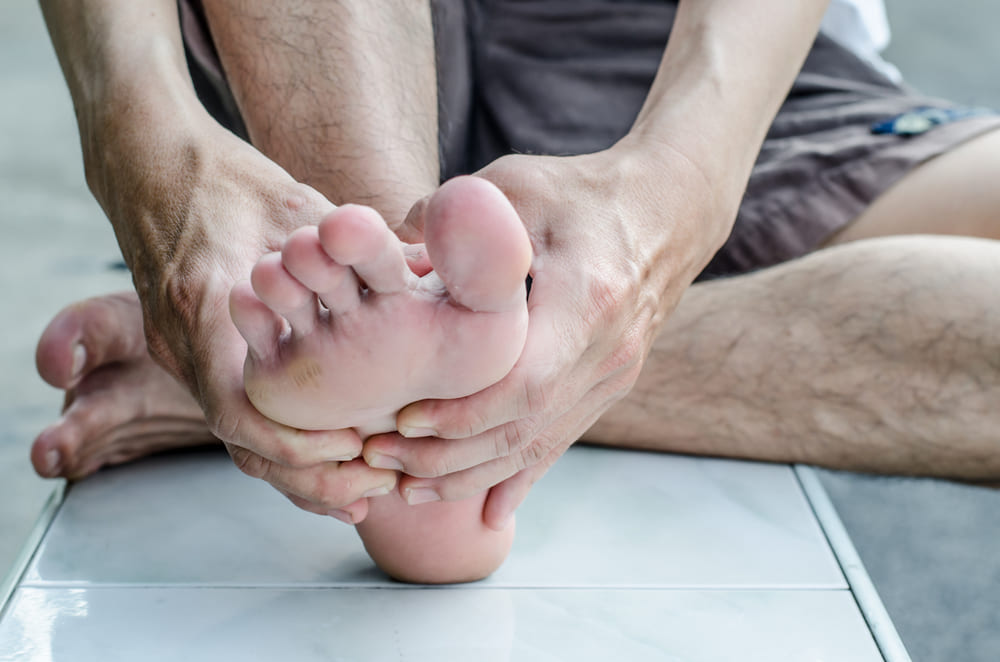Looking for Expert-Level VA Claim Answers?📱Call Us Now! 737-295-2226
If you’re a veteran dealing with persistent athlete’s foot (tinea pedis), you might be eligible for VA disability compensation. This common fungal infection doesn’t just cause itching and irritation. In many cases, it can spread, worsen, and interfere with your daily life.
In this guide, we’ll explain how the VA rates tinea pedis, including bilateral cases, what evidence you need, and how to file a strong VA claim to get the rating and benefits you’ve earned.
Table of Contents
Summary of Key Points
- Tinea pedis (athlete’s foot) is a fungal skin infection that may qualify veterans for VA disability compensation if service-connected.
- VA ratings for tinea pedis range from 0% to 60%, depending on severity, body area affected, and treatment type (topical vs. systemic).
- Bilateral tinea pedis may increase a veteran’s disability rating due to the added impact on mobility and quality of life.
What is Tinea Pedis?

Athlete’s foot, medically known as tinea pedis, is a fungal infection affecting the skin, typically starting between the toes. This condition frequently manifests in individuals whose feet experience excessive perspiration, particularly when enclosed in snug footwear.
Tinea Pedis in Veterans
The origins of tinea pedis are deeply intertwined with the living conditions commonly encountered by veterans during their service.
Those familiar with armed service training or active duty abroad understand the scarcity of even shared shower facilities, with damp tiled floors becoming breeding grounds for the bacteria responsible for tinea pedis.
The moniker “athlete’s foot” reflects its penchant for thriving in dark, damp, and poorly ventilated shoes, a familiar environment for those who have endured miles in heavy, waterproofed combat boots.
Beyond the service period, tinea pedis may emerge as a consequence of other service-related conditions affecting mobility during a veteran’s retirement.
These pre-existing disabilities not only heighten the likelihood of tinea pedis development but also place disabled veterans at a greater risk of complications stemming from the spread of the infection.
Tinea Pedis VA Ratings
Veterans with dermatophytosis (tinea pedis and tinea cruris) and calluses may qualify to receive Athlete’s Foot VA ratings of 0%, 10%, 30%, or 60%, as determined under diagnostic codes 7813 and 7806.
The General Rating Formula for the Skin for DCs 7806, 7809, 7813–7816, 7820–7822, and 7824 is structured based on the severity of skin conditions, with corresponding percentages determining the disability rating.
- 60% VA Rating: A VA rating of 60% is assigned if characteristic lesions cover more than 40 percent of the entire body or exposed areas or if constant or near-constant systemic therapy, such as corticosteroids, phototherapy, retinoids, biologics, or other immunosuppressive drugs, has been required over the past 12-month period.
- 30% VA Rating: A 30% VA rating is given if lesions involve 20-40 percent of the body or exposed areas or if systemic therapy has been required for a total duration of 6 weeks or more, though not constantly, in the past year.
- 10% VA Rating: A 10% VA rating applies to characteristic lesions covering 5 percent to less than 20 percent of the body or intermittent systemic therapy lasting less than 6 weeks over the past 12 months.
- 0% VA Rating: A 0% VA rating is assigned when less than 5 percent of the body is affected, and only topical therapy has been required over the past year. This organized rating system ensures a comprehensive evaluation of skin conditions for an accurate disability rating.
Bilateral Tinea Pedis VA Disability
When evaluating veterans with bilateral tinea pedis in both feet, the VA considers the overall impact of the condition on the veterans’ health and well-being.
Bilateral conditions often result in a higher athlete’s foot VA disability rating, reflecting the additional challenges faced by veterans with tinea pedis affecting both feet.
Service Connection
Veterans suffering from tinea pedis because of their military service should know how to prove a service connection in order to win their VA disability claim.
To receive a Tinea Pedis VA disability rating, you must meet the following requirements:
- A current medical diagnosis of tinea pedis
- An in-service event, injury, illness, or aggravation
- A medical nexus (or link) between the current diagnosis and the in-service event, injury, or illness (can be a Nexus Letter)

How to File Your VA Claim
Filing an Athlete’s Foot VA claim consists of the following five steps:
- Gather Documentation: Collect medical records showing current diagnosis, test results, service records, and other evidence, such as Medical Nexus Letter or Independent Medical Opinion (IMO) linking your tinea pedis to your military service.
- Complete VA Form 21-526EZ: Fill out this form to apply for disability compensation. Include details about your exposure, symptoms, and how it affects your daily life.
- Submit Your VA Claim: Send the completed form and supporting documents to the VA regional office handling your claim. You can submit it online through the VA website, by mail, or in person.
- Undergo Examinations: The VA might schedule you for medical examinations to evaluate the extent of your tinea pedis.
- Await the Decision: The VA will review your claim, considering the evidence provided.
The VA will notify you of their decision regarding your eligibility for a tinea pedis VA disability rating, including VA benefits and compensation.
Conclusion
Athlete’s foot might sound minor, but for many veterans, tinea pedis can be painful, persistent, and directly linked to military service. If it’s affecting your health, comfort, or mobility, don’t overlook your right to file a VA disability claim.
Understanding the VA’s rating system (and backing your claim with the right medical evidence) can help you secure the VA compensation and benefits you deserve. You served. You deserve. Make sure you’re getting all the benefits you’ve earned.
NEED MORE ASSISTANCE? WE GOT YOUR SIX!
Most veterans are underrated for their disabilities and, therefore, not getting their due compensation. At VA Claims Insider, we help you understand how to take control of the claims process so you can get the rating and compensation you’re owed by law. Our process takes the guesswork out of filing a VA disability claim and supports you every step of the way in building a fully-developed claim (FDC)—so you can get what you deserve in less time!
If you’ve filed your VA disability claim and have been denied or have received a low rating—or you’re unsure how to get started—reach out to us! Take advantage of a VA Claim Discovery Call. Learn what you’ve been missing—so you can FINALLY get the disability rating and compensation YOU DESERVE!
FAQs
Can you get a tinea pedis VA rating?
Yes. To receive a tinea pedis VA rating, you need a current medical diagnosis, an in-service event, injury, illness, or aggravation, and a medical nexus connecting your diagnosis with your service.
What are the tinea pedis VA ratings available?
It’s possible to receive a tinea pedis VA rating of 0%, 10%, 30%, or 60%, depending severity of symptoms.
Can veterans receive compensation for bilateral tinea pedis?
Yes. Veterans with tinea pedis affecting both feet (bilateral tinea pedis) may be eligible for a higher VA disability rating to account for the added challenges of the bilateral factor.
What evidence is required for a successful VA claim for tinea pedis?
Comprehensive medical evidence, including diagnosis, treatment history, and details on how tinea pedis affects daily life, strengthens a VA disability claim.
Are there specific VA benefits for veterans with tinea pedis beyond compensation?
Yes, veterans with tinea pedis may also be eligible for additional VA benefits, such as healthcare services, depending on the severity and impact of their condition.
How can veterans appeal a VA decision regarding their tinea pedis disability rating?
If veterans aren’t happy with a decision from the VA, they can appeal it. The appeal process means providing more proof, attending hearings if needed, and following the steps to ask for a second look or a change in their tinea pedis disability rating. See also Options if Your VA Claim is Denied.
Can chronic tinea pedis lead to other complications?
Yes. If left untreated, tinea pedis can spread to the toenails (onychomycosis), cause secondary infections, and worsen other service-connected conditions like diabetes or neuropathy.
What if my athlete’s foot keeps coming back after treatment?
Recurring tinea pedis may support a higher VA rating if it requires near-constant treatment or affects larger body areas over time. Be sure to document flare-ups and all treatments in your medical records.
Author

Eric Webb
Eric has written and worked in the field of Veterans Disability since 2020 and enjoys writing educational content for the veteran population. His prior work has been published in the Official Journal of the American College of Sports Medicine (ACSM). He holds a Degree in Health and Exercise Science.


